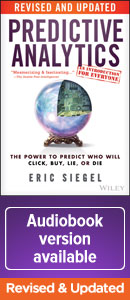
The art of putting Big Data to practical use is still young, but it’s already more pervasive than you probably realize, says a new book.
FORTUNE — Early last year, you might recall, Target found itself at the center of a storm of outrage. The retailer’s number crunchers had come up with a statistical method for predicting which of its customers were most likely to become pregnant in the near future, giving Target’s marketers a head start on pitching them baby products.
The model worked: Target (TGT) expanded its customer base for pregnancy and infant-care products by about 30%. But the media brouhaha, with everyone from The New York Times to Fox News accusing the company of “spying” on shoppers, took weeks to die down.
If Target’s success at setting its sights on potential moms-to-be gives you the creeps, Eric Siegel’s new book could ruin your whole day. Siegel is a former Columbia professor whose company, Predictive Impact, builds mathematical models that cull valuable nuggets of data from floods of raw information. Companies use the tools to forecast everything from what we’ll shop for, to which movies we’ll watch, to how likely we are to be in a car accident or default on our credit cards.
 In Predictive Analytics: The Power to Predict Who Will Click, Buy, Lie, or Die, Siegel explains how these models work and where the pitfalls are, in clear, colorful terms. Simply put, predictive analytics, or PA, is the science of learning from experience. Starting with data about the past and current behavior of a given group of people — whether customers, patients, prison inmates up for parole, voters, or employees — analysts can predict what they’ll probably do next.
In Predictive Analytics: The Power to Predict Who Will Click, Buy, Lie, or Die, Siegel explains how these models work and where the pitfalls are, in clear, colorful terms. Simply put, predictive analytics, or PA, is the science of learning from experience. Starting with data about the past and current behavior of a given group of people — whether customers, patients, prison inmates up for parole, voters, or employees — analysts can predict what they’ll probably do next.
This kind of high-tech crystal ball is behind “the growing trend to make decisions more ‘data driven,'” Siegel writes. “In fact, an organization that doesn’t leverage its data in this way is like a person with a photographic memory who never bothers to think.”
Predictive Analytics is packed with examples of how Citi (C), Facebook (FB), Ford (F), IBM (IBM), Google (GOOG), Netflix (NFLX), PayPal and many other businesses and government agencies have put PA to work. Pfizer (PFE), for instance, has a predictive model to foretell the likelihood that a patient will respond to a given new drug within three weeks. LinkedIn (LNKD) uses PA to pinpoint the fellow members you might want as connections. At the IRS, a mathematical ranking system applied to past tax returns “empowered IRS analysts to find 25 times more tax evasion, without increasing the number of investigations.”
And then there’s Hewlett-Packard (HPQ). A couple of years ago, alarmed by annual turnover rates in some divisions as high as 20%, HP decided to try anticipating which of its 330,000 employees worldwide were most likely to quit. Beginning with reams of data on things like salaries, raises, promotions, and job rotations, a team of analysts correlated that information with detailed employment records of people who had already left. Based on the similarities they found, the researchers assigned each current employee a Flight Risk score.
So far, the model seems to be helping to reduce turnover, but “some devoted HP workers are bound to be uncomfortable that their Flight Risk score exists,” Siegel notes, adding that such tools represent “a whole new breed of powerful human resources data,” which, since it’s highly speculative, is either “insight or intrusion,” depending on how managers use it.
Despite his status as a Big Data guru, Siegel echoes some of the same concerns as the pundits who squawked about Target. Calling predictive analytics “a tool that can serve both good and evil,” he believes that widespread worries about privacy should not be dismissed.
“Dialogue is critical, and ‘check here to agree to our lengthy privacy policy that you are too busy to read’ does not count as dialogue,” he writes. “Organizations and consumers are not speaking the same language. Striking a balance, together, is society’s big new challenge. We have a long way to go.”
By Anne Fisher, contributor
Originally published at CNNMoney